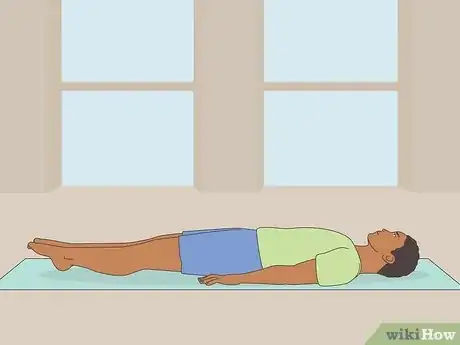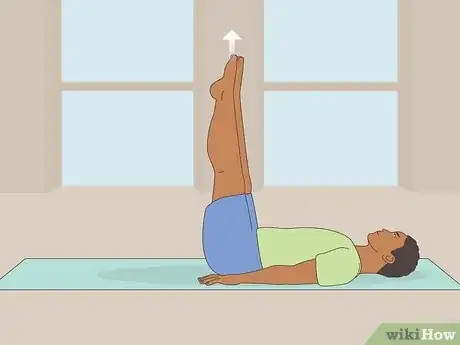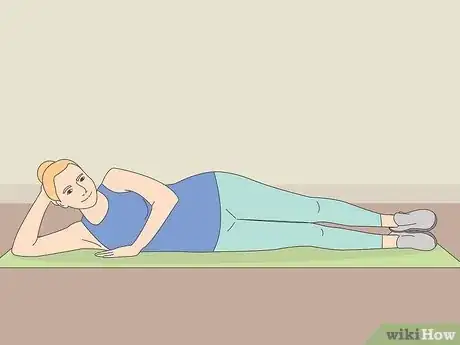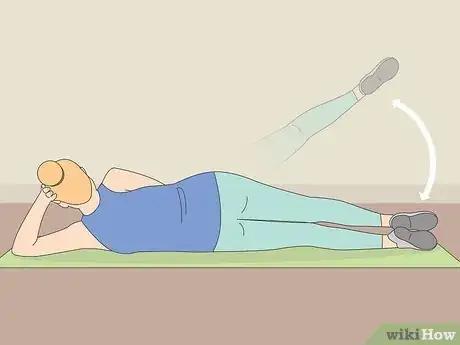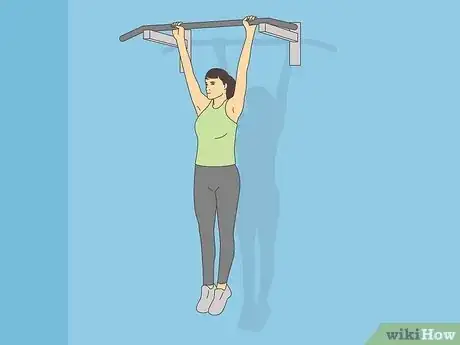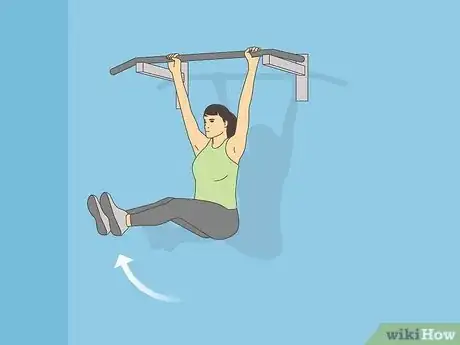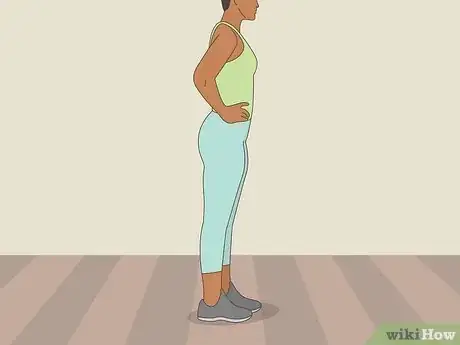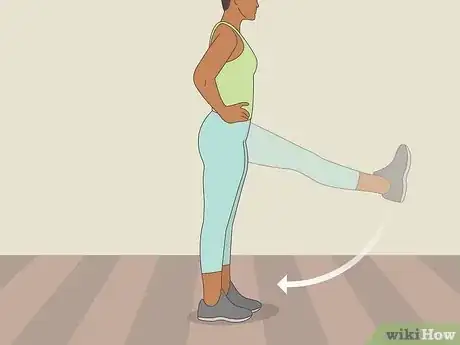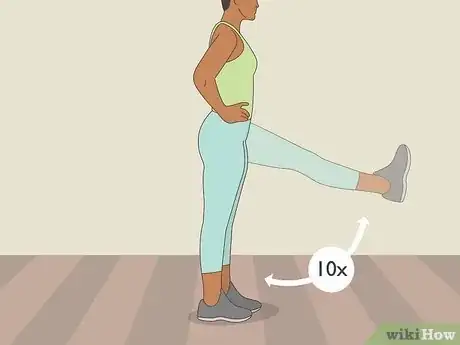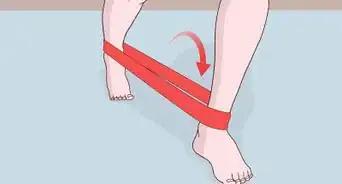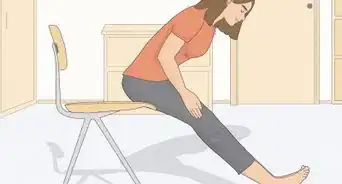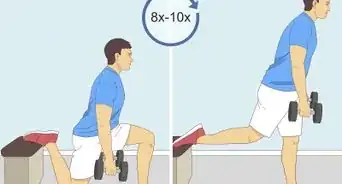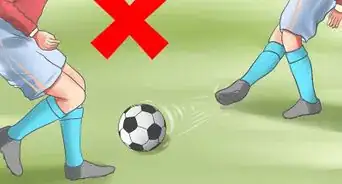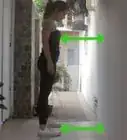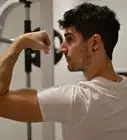This article was co-authored by Danny Gordon and by wikiHow staff writer, Luke Smith, MFA. Danny Gordon is an American College of Sports Medicine (ACSM) Certified Personal Trainer and Owner of The Body Studio for Fitness, a fitness studio based in the San Francisco Bay Area. With over 20 years of physical training and teaching experience, he has focused his studio on semi-private personal training. Danny received his Personal Trainer Certification from the California State University, East Bay and the American College of Sports Medicine (ACSM).
wikiHow marks an article as reader-approved once it receives enough positive feedback. This article has 17 testimonials from our readers, earning it our reader-approved status.
This article has been viewed 1,667,992 times.
It’s difficult to work your lower core—it’s a tricky area of your body to target, and the common exercises that do, like crunches or situps, can be hard to perform. But those six-pack abs won’t sculpt themselves, right? Allow us to introduce you to leg lifts. These simple, do-anywhere exercises work your abdominals, hip flexors, back, and legs. We’ve put together an easy-to-follow guide that will walk you through 5 leg lift exercises that anyone can do, from pro bodybuilders to absolute beginners. Whether you’re looking for that washboard stomach, or just wanting to strengthen up your core, look no further than leg lifts.
Things You Should Know
- Perform leg lifts by lying with your back flat on the ground and slowly raising and lowering your legs.
- Do side leg lifts, hanging leg lifts, and leg lifts with a medicine ball in order to vary the workout and add challenge.
- Do Standing leg lifts for an easier, more accessible workout option.
Steps
Vertical Leg Lifts
-
1Lie flat on your back with your legs stretched out in front of you. Your legs should just be a toe's width apart. Make sure to keep your palms flat on the ground near your sides.[1] Use an exercise or yoga mat for extra support and comfort.
- If you experience occasional back pain, you can roll a towel and place it under the arch of your back, just above your hips.
- Additionally, if you lay on a workout bench instead of on the floor, it will improve your range of motion and allow you to lift/lower your legs farther.[2]
-
2Bend your knees and raise your legs. Position your calves parallel to the ground, with your thighs perpendicular to your calves, forming a right angle with your knee. Keep your toes pointed while you do this, drawing your abdominal muscles toward your spine.[3]
- Be sure to contract your abdominals to push your lower back into the floor; there should not be any gap between them. This helps you target the abdominal muscles while protecting your spine.
- Lift your chin, and keep your eyes and face directed at the ceiling and avoid the temptation to strain your neck to look at your legs. This will help you avoid pain in your neck.
Advertisement -
3Straighten your legs until your feet are pointed at the ceiling. Keep your toes pointed and raise your legs as slowly as possible. Remember not to let your lower back arch off the ground, or you may injure yourself and you won't be getting as good of a workout.[4]
- To make it more challenging: skip Step 2 and raise your legs to the ceiling without bending them. This increases the effort needed to complete the rep, and works both your legs and core harder.
-
4Bring your legs down slowly. Bring them down as far as you can while keeping your back flat against the floor. Your eventual goal is to reach about an inch off the floor. Don't just let gravity work for you—make sure you're in control. Hold your arms in the same place, but use them to support you as you lower your legs.[5]
- Remember to breathe throughout the exercise, and resist the temptation to let your feet touch the floor. This will ensure you get the best workout possible.
- Keep your lower back pressed into the floor to engage your abdominals and protect your spine. This will get harder the closer your feet get to the floor, so only lower as far as you can while not arching your back.
- If you feel your lower back arching up off the floor, don't lower your legs down as far. As your abdominals get stronger, you will be able to lower your feet closer to the floor using proper form.
-
5Repeat 3 sets of 10-20 leg lifts. Start with 3 sets of 10 and build your way up to 3 sets of 20. Slow it down for even more of a challenge, lifting your straightened legs all the way up on a count of ten, and then lowering them down while counting to ten again. Leg lifts like this are a great way to build leg muscles without weights.[6]
- To make it more challenging: practice raising your feet about 20%, holding for one second, raising them 20% more, holding for one second, and continuing this until you get them as high as they need to be.
- To make it easier: raise only a single leg at a time, while keeping the other flat on the floor. If you opt for this method, do 3 sets of 10 lifts for each leg, for a total of 6 sets.


Certified Fitness Coach
Did You Know? Aim to eat more lean protein and lots of veggies and whole grains and try to get in 30 minutes of light cardio a day. This will lower your body fat percentage and give your leg muscles more definition.
Side Leg Lifts
-
1Lie on your side with your head resting on your hand. Position your body in one straight line, with your spine, knees, and legs all aligned. Keep your elbow on the floor to help support your head.
- Keep your other arm in front of you with your palm facing down.[7]
-
2Lift your top leg about 45°. Raise it slowly, an aim to have your raised foot hover about 2–3 feet (0.61–0.91 m) above the ground. Hold this position for 3-5 seconds. Keep looking straight in front of you instead of looking up at the leg.[8]
- You can keep your free hand either on your hip or on the floor in front of you for some additional support.
- Make sure you keep your hips stacked and your torso still.
-
3Lower your leg to the resting position. Keep your body in the same position and slowly lower your raised leg until it meets the other leg. Remember to keep your spine straight and to avoid caving forward as you lift your leg.[9]
- To make it more challenging: Lower your leg, but keep it about an inch away from the bottom leg to feel an extra burn in your side.
-
4Perform 10 reps with either leg. Once you've finished with one leg, roll over onto your other side and repeat the workout with the opposite leg. Remember to keep breathing throughout the exercise, and don’t rush through it.[10]
- To make it more challenging: wear ankle weights or wrap a resistance band around your ankles to add opposing force, making your thighs, butt, and core work harder in the process.
- This is a great exercise to build leg muscles, reinforce your hips, and shape your butt![11] Most leg lifts are focused on working out the front of your body, so this is a great way to get that full-body workout!
Leg Lifts with a Ball
-
1Lie flat on the ground with a medicine ball held between your feet. Lie down with your arms at your sides with your legs out in front of you. Use a yoga or exercise mat for your comfort. Keep both your spine and your palms flat on the ground, aligning your whole body into a straight line.[12]
- Start small, with a medicine ball of 2–3 pounds (0.91–1.36 kg), increasing the weight when you feel you need the extra challenge.
- You can also use a dumbbell, which happens to be a bit easier to grip between your feet.
-
2Lift the medicine ball with your legs. Carefully, raise your legs and the medicine ball as high as you can, stopping when your legs are perpendicular to your body. Try to hold this position for a couple seconds.[13]
- Be careful not to drop the ball. If you feel uncertain about your grip, lower the ball to the floor and readjust.
-
3Lower your legs as slowly as possible. The slower you go, the more you resist gravity and force your muscles to maintain control, and the more you’ll be able to tone your abs. For added challenge, resist lowering your feet all the way to the floor, instead holding them about 2 inches (5.1 cm) above the ground, then doing your next rep.[14]
- This is a great workout for your abdominal muscles, though it can take a bit more effort than regular leg lifts.
-
4Perform 3 sets of 5-10 leg lifts. Since these exercises are a bit harder, you should start off by doing fewer of them until you feel ready for more. Don’t push yourself too hard; pay attention to your body. Then, you can move to doing 3 sets of 10-20 leg lifts with the added weight.
-
5Add an extra challenge by passing the ball to your hands. Raise your arms as you lift the ball with your feet. Then, at the peak of the lift, pass the ball to your arms, and slowly lower your body back to the starting position, with the ball held on the floor above your head. This adds an upper-body workout, and exercises your core more intensely than the base workout.[15]
Hanging Leg Lifts
-
1Use your arms to hang from a bar or gymnastic rings. Keep your hands/arms a bit more than shoulder width apart, with a firm grip on the bar. Look straight ahead of you to avoid straining your neck. Keep your body still and even, with your feet together. Your fingertips should be facing away from you.[16]
- If you're at a gym, the bar may have extra handles to support your hands.
- This version of the leg raise targets your core and your lats, and has the added benefit of training you for things like deadlifts and squats, if you want to expand your workout.
-
2Raise your legs until they are perpendicular to your body. Take 5-8 seconds to lift your legs until they are parallel to the ground. Keep your toes pointed and your back straight. Avoid the temptation to hunch over or to curl in toward your legs.[17]
- You may not be able to raise your legs all the way up at first. That’s okay! Raise them as high as you can, and over time you’ll build up enough strength to do the full workout.
-
3Lower your legs slowly. Once your legs have reached their maximum height and you feel that slow burn in your core, gently lower them down. Try going as slowly as you can to work your muscles even harder, taking 5-8 seconds to lower your legs back to the starting position.[18]
- Make sure you lower your legs slowly so that you are doing the work instead of relying on the momentum of your legs dropping.
-
4Repeat 3 sets of 10 hanging leg lifts. As you get more comfortable, you can increase to 3 sets of 20 hanging leg lifts. Dor only as many as you can comfortably perform without straining yourself, and be sure to keep your torso still.[19]
- The hanging variation of the leg lift exercise is better for people with back problems because it does not put the same amount of pressure on your back as it does when you do them lying down.
-
5Make it easier if you need to. If these legs lifts are too challenging, you can raise your legs with bent knees instead. For this variation of the exercise, bend your knees and keep your legs together while raising your knees as high as they can go, nearly up to your chest. Then, lower your legs and start again. This exercise is a bit less strenuous for the abdominal muscles. [20]
- To make it more challenging: Wear ankle weights to add resistance as you raise your legs.
Standing Leg Lifts
-
1Stand with your feet aligned with your hips. Place your hands on your hips for balance, and straighten your back. Bend your knees slightly, but form your body into one tall, straight line otherwise.[21]
- Standing leg lifts are great for people just starting to build core and leg strength, or people with physical impairments that don’t allow traditional leg lifts.
-
2Raise your right leg. With your hands still on your hips, balance your weight to one leg, and slowly lift the other out in front of you, about 1 foot (0.30 m) off the ground, or as high as you can comfortably lift. Keep this leg straight and your toe pointed out.[22]
- Take about 3 seconds to raise your leg, then hold it in the air for another 3 seconds.
-
3Lower your raised leg. While keeping your balance, take about 3 seconds to lower your raised leg back to the starting position. Take another 3 seconds to rest, standing straight and breathing steadily. Keep your eyes focused ahead of you.[23]
-
4Repeat for 10 reps on both legs. Once you’ve raised and lowered your first leg 10 time, shift your weight to the other leg and repeat the exercise another 10 times. Once you’re comfortable with this amount, you can add more sets of standing leg lifts to your workout.[24]
Community Q&A
-
QuestionWill this affect my height?
 Community AnswerNo. There are rumors that it can, but they're not true.
Community AnswerNo. There are rumors that it can, but they're not true. -
QuestionWhich leg works out my left abdomen?
 Community AnswerYour left leg.
Community AnswerYour left leg. -
QuestionIs it helpful for a 13-year-old girl in flattening belly?
 Community AnswerWhile any exercise will help lose excess fat, leg lifts work and strengthen the leg muscles. If you would like to lose weight around your stomach, you should do more cardio and abs. You might also want to adapt a healthier eating habits, if you haven't already.
Community AnswerWhile any exercise will help lose excess fat, leg lifts work and strengthen the leg muscles. If you would like to lose weight around your stomach, you should do more cardio and abs. You might also want to adapt a healthier eating habits, if you haven't already.
Warnings
- If you begin to feel faint or dizzy, stop exercising and consult medical help. If you continue feeling dizzy, don't be afraid to seek medical attention.⧼thumbs_response⧽
- When you're adding a medicine ball to your exercise, be certain that you can hold it firmly between your legs. Having it drop onto your body is painful.⧼thumbs_response⧽
References
- ↑ https://www.coachmag.co.uk/exercises/abs-workout/172/instant-six-pack-fix-bench-leg-raises
- ↑ https://theworkoutdigest.com/sit-up-bench-exercises/
- ↑ https://www.coachmag.co.uk/exercises/abs-workout/172/instant-six-pack-fix-bench-leg-raises
- ↑ https://www.coachmag.co.uk/exercises/abs-workout/172/instant-six-pack-fix-bench-leg-raises
- ↑ https://www.coachmag.co.uk/exercises/abs-workout/172/instant-six-pack-fix-bench-leg-raises
- ↑ https://www.coachmag.co.uk/exercises/abs-workout/172/instant-six-pack-fix-bench-leg-raises
- ↑ https://www.ppcsd.org/site/handlers/filedownload.ashx?moduleinstanceid=2037&dataid=1375&FileName=hip%20exercises.pdf
- ↑ https://www.ppcsd.org/site/handlers/filedownload.ashx?moduleinstanceid=2037&dataid=1375&FileName=hip%20exercises.pdf
- ↑ https://www.ppcsd.org/site/handlers/filedownload.ashx?moduleinstanceid=2037&dataid=1375&FileName=hip%20exercises.pdf
- ↑ https://www.ppcsd.org/site/handlers/filedownload.ashx?moduleinstanceid=2037&dataid=1375&FileName=hip%20exercises.pdf
- ↑ https://www.coachmag.co.uk/exercises/abs-workout/172/instant-six-pack-fix-bench-leg-raises
- ↑ https://www.coachmag.co.uk/exercises/abs-workout/172/instant-six-pack-fix-bench-leg-raises
- ↑ https://www.coachmag.co.uk/exercises/abs-workout/172/instant-six-pack-fix-bench-leg-raises
- ↑ https://www.coachmag.co.uk/exercises/abs-workout/172/instant-six-pack-fix-bench-leg-raises
- ↑ https://www.fitness.com/workouts/v-sit-partial
- ↑ https://www.coachmag.co.uk/exercises/abs-workout/172/instant-six-pack-fix-bench-leg-raises
- ↑ https://www.coachmag.co.uk/exercises/abs-workout/172/instant-six-pack-fix-bench-leg-raises
- ↑ https://www.coachmag.co.uk/exercises/abs-workout/172/instant-six-pack-fix-bench-leg-raises
- ↑ https://www.coachmag.co.uk/exercises/abs-workout/3657/3a-hanging-leg-raise
- ↑ https://www.coachmag.co.uk/exercises/abs-workout/3657/3a-hanging-leg-raise
- ↑ https://www.cnn.com/2020/12/18/health/pain-relief-neck-back-knee-workout-wellness/index.html
- ↑ https://www.cnn.com/2020/12/18/health/pain-relief-neck-back-knee-workout-wellness/index.html
- ↑ https://www.cnn.com/2020/12/18/health/pain-relief-neck-back-knee-workout-wellness/index.html
- ↑ https://www.cnn.com/2020/12/18/health/pain-relief-neck-back-knee-workout-wellness/index.html
About This Article
To do leg lifts, start by lying flat on the floor with your legs stretched in front of you and your arms at your sides. Then, bend your knees and raise your legs so that your calves are parallel to the ground. Next, keep your abs contracted as you straighten your legs toward the ceiling. Slowly bring your legs back down without actually letting them touch the ground. Keep breathing steadily and repeat this exercise up to 20 times. Then, take a short break and do two more sets. For side-laying and hanging variations of leg lifts, keep reading!
